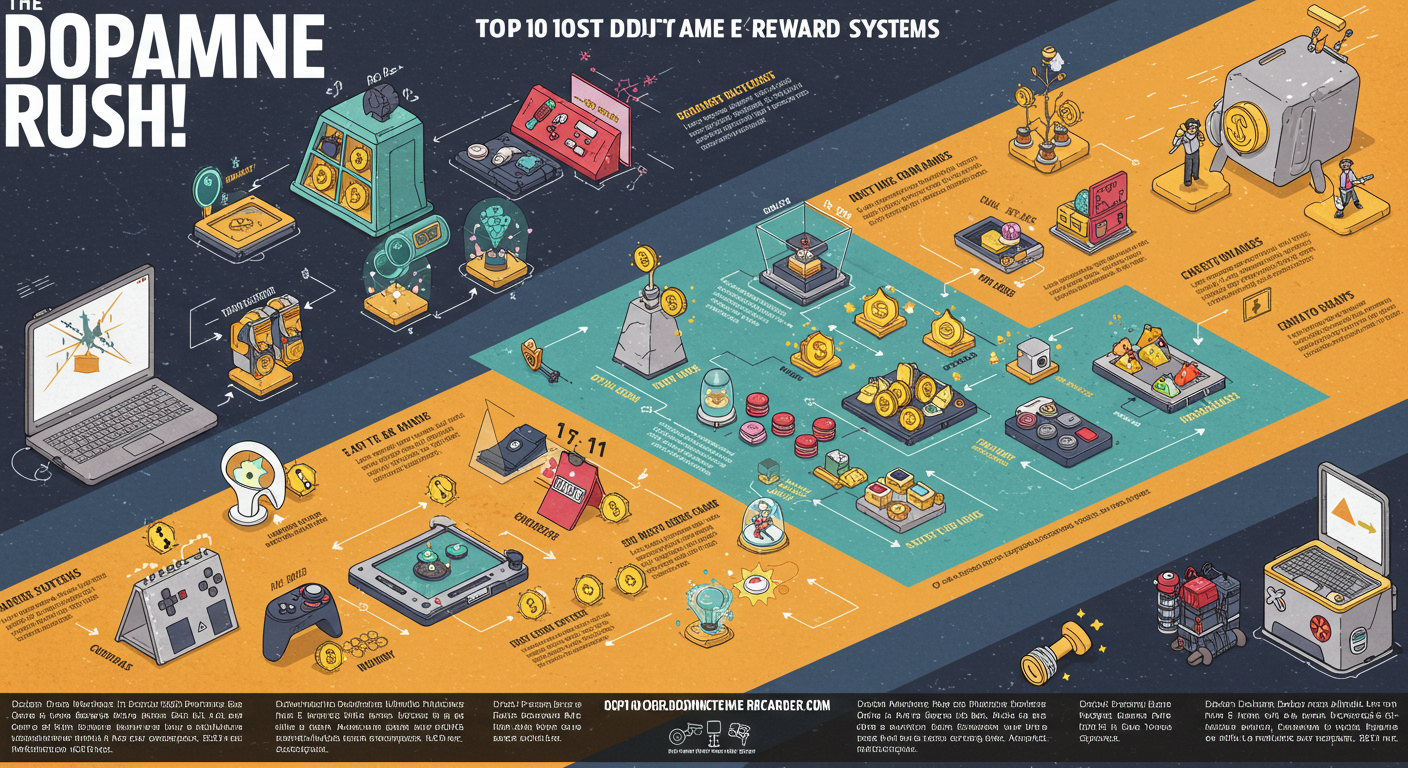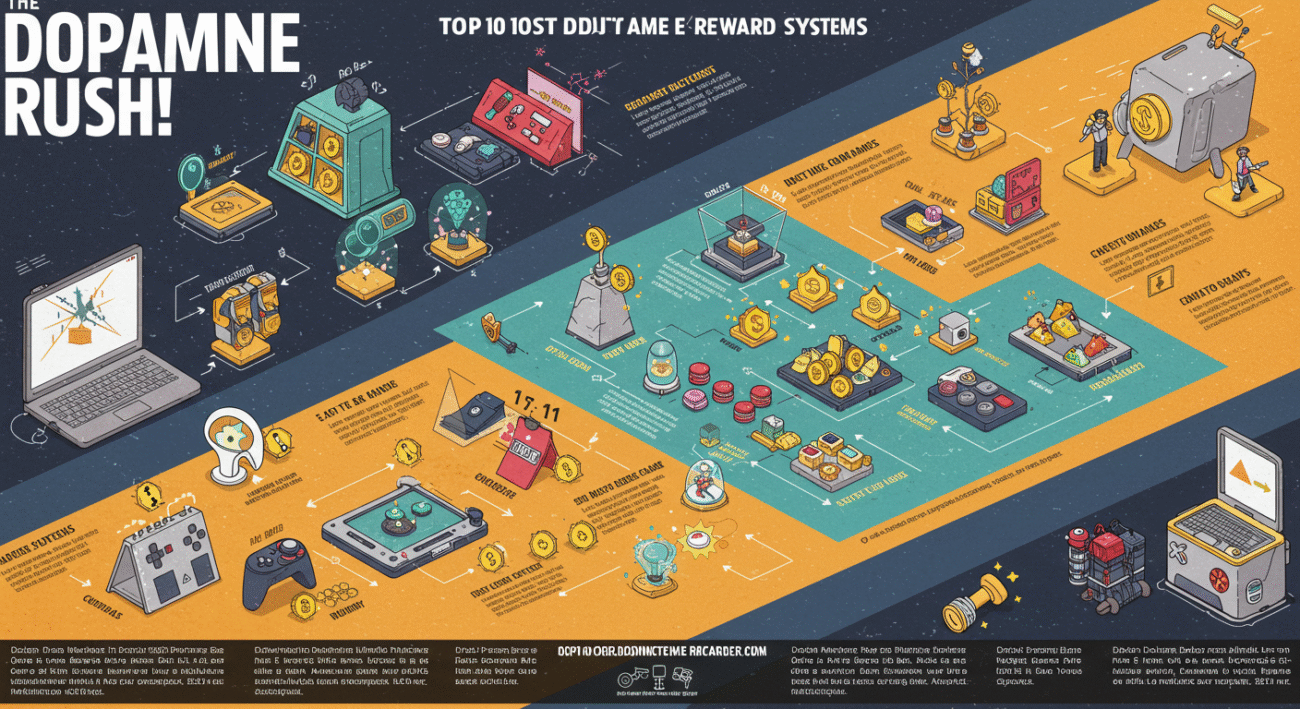The Digital Dopamine Rush: Top 10 Most Addictive Game Reward Systems
In the ever-evolving landscape of video games, developers are constantly innovating to capture and retain player attention. Beyond compelling narratives and breathtaking graphics lies a powerful, often invisible, force: the reward system. These meticulously crafted mechanics tap into fundamental human psychology, creating compelling loops that keep players coming back for more. From the satisfying ding of a rare loot drop to the daily ritual of logging in for a special bonus, these systems are the engines of engagement, driving players to invest not just their time, but often their money. This article delves into the top 10 most addictive game reward systems, exploring the psychological hooks that make them so effective and the games that have mastered their implementation.
The Psychology of Reward: Why We Get Hooked

At the heart of any addictive reward system is the brain’s “feel-good” neurotransmitter, dopamine.[1] Game developers have become adept at creating “compulsion loops,” a three-part cycle of anticipation, activity, and reward.[2] The anticipation of a potential reward triggers dopamine production, and the eventual acquisition of that reward provides a pleasurable release, reinforcing the behavior.[2]
A key principle at play is the variable-ratio reinforcement schedule, a concept borrowed from behavioral psychology. Much like a slot machine, when rewards are unpredictable, the brain remains in a heightened state of anticipation, making the experience more exciting and compelling.[3][4] This is why the random nature of loot drops or the chance-based mechanics of gacha systems are so potent.[3][4]
Other powerful psychological drivers include the fear of missing out (FOMO), which is often exploited by limited-time events and daily login bonuses, and the innate human desires for mastery, achievement, and social validation.[1]
Here are the top 10 most addictive game reward systems that masterfully employ these psychological principles:
1. The Battle Pass: A Tiered Temptation
Pioneered in its modern form by games like Dota 2 and popularized to a massive extent by Fortnite, the battle pass is a tiered system that rewards players with a stream of cosmetics and other in-game items for playing and completing challenges.[5][6][7] Players can progress through a free track with limited rewards, but the real allure lies in the premium paid track, which offers a much more substantial and desirable set of items.[7]
The battle pass is a masterclass in psychological engagement. It provides a clear path of progression, giving players a constant sense of accomplishment as they unlock each new tier.[8] The time-limited nature of each season’s battle pass also heavily leverages FOMO, encouraging consistent play to unlock all the rewards before they’re gone.[6] Furthermore, many battle passes, like Fortnite’s, offer enough premium currency within their paid track to purchase the next season’s pass, creating a powerful retention loop.[5]
2. The Gacha System: A Digital Treasure Chest
The gacha system, a digital evolution of the capsule-toy vending machine, is a monetization model where players spend in-game currency (often purchasable with real money) for a chance to receive a random in-game item.[4] This system is the cornerstone of many popular mobile games, most notably Genshin Impact and Fate/Grand Order.[4][9]
The addictive nature of gacha lies in its powerful use of variable-ratio reinforcement. The thrill of the unknown, the possibility of obtaining a rare and powerful character or weapon with each “pull,” creates a compelling and often costly loop.[9] These games often feature “pity” systems that guarantee a high-rarity item after a certain number of pulls, providing a safety net that can ironically encourage further spending.[10][11] The constant introduction of new, desirable characters and items in limited-time banners further fuels the desire to engage with the gacha system.[9]
3. The Loot Drop: The Thrill of the Hunt
The quintessential reward system in many genres, especially role-playing games, is the loot drop. The act of defeating a powerful enemy or opening a treasure chest to reveal a shower of glittering items is a core part of the appeal of games like the Diablo series and World of Warcraft.[3][12]
The addictiveness of loot drops stems from their inherent randomness. Loot is often color-coded by rarity, from common to legendary or unique, creating a clear hierarchy of desire.[3][13] The “smart loot” systems in games like Diablo 4 ensure that a higher percentage of drops are relevant to the player’s class, making the hunt for better gear more consistently rewarding.[14] The constant pursuit of a “perfect roll” on an item’s stats or a rare, build-defining unique item can keep players engaged for hundreds, if not thousands, of hours.[3]
4. Daily Login Rewards and Streaks: Cultivating Habit
A staple of mobile gaming, daily login rewards and streaks are designed to make playing a daily habit.[15] Games like Candy Crush Saga and Pokémon GO offer players a small reward simply for opening the app each day.[16][17] These rewards often escalate with consecutive daily logins, creating a “streak” that players are reluctant to break.[15]
This system preys on the psychological principle of loss aversion; the fear of losing a long-standing streak can be a powerful motivator to log in, even if just for a moment.[18] Some games even offer the option to pay to restore a broken streak, further highlighting its perceived value.[15] These daily rewards, while often small, effectively create a low-friction entry point back into the game each day.
5. Progression and Prestige Systems: The Endless Climb
A sense of constant progression is a powerful motivator, and many games have perfected the art of the endless climb.[4] Games like Call of Duty feature a robust player leveling system where experience points unlock new weapons, equipment, and cosmetic items.[2][19] Once players reach the maximum level, they are often given the option to “Prestige,” resetting their level in exchange for exclusive rewards and a new symbol of their dedication.[2][19]
This system provides players with a continuous sense of accomplishment and clear goals to strive for. The allure of unlocking every attachment for every weapon, or achieving the highest Prestige rank, can create a long-term engagement loop that keeps players invested in the game’s ecosystem.
6. The Collection and Completion Incentive: Gotta Catch ‘Em All!
Tapping into the innate human desire to collect and complete sets, this reward system is powerfully demonstrated in games like Pokémon GO. The game’s iconic slogan, “Gotta Catch ‘Em All,” perfectly encapsulates this addictive mechanic.[16] The drive to find and capture every available Pokémon, to fill out the Pokédex, is a primary motivator for players.[17]
This is an example of the Zeigarnik effect, where the brain remembers incomplete tasks more than completed ones.[17] An incomplete collection creates a psychological tension that can only be resolved by finding the missing pieces. The introduction of rare, shiny, and regional variants of Pokémon further fuels this desire for completion.
7. Time-Gated Content and Upgrades: The Waiting Game
Strategy games like Clash of Clans employ a highly effective, and sometimes frustrating, reward system centered around time-gated upgrades.[12] Constructing or upgrading buildings and training troops requires a set amount of real-world time to complete.[12] While players can wait for these timers to count down, they are often presented with the option to spend premium currency to speed up the process.
This system creates a compelling loop of logging in to start new upgrades, and then returning later to reap the rewards. The game subtly plants a seed in the player’s mind about when an upgrade will be complete, encouraging them to constantly check back in.[12] This creates a powerful incentive to either remain patient and consistently engaged over long periods or to spend money for instant gratification.
8. Social Reward Structures: The Power of Community
In many online games, the rewards are not just about individual gain but also about social status and belonging. MMORPGs like World of Warcraft have intricate social structures built around guilds and raiding.[1] The coordination and teamwork required to defeat a powerful raid boss and distribute the rare loot that follows fosters a strong sense of community and shared accomplishment.[12]
Games like Among Us leverage social deduction as a core reward. The thrill of successfully deceiving other players as an imposter, or the satisfaction of correctly identifying and ejecting the traitor, provides a powerful social and psychological reward.[20][21] These systems tap into our need for social connection and validation, making the game more engaging and memorable.
9. Creator-Driven Rewards: The Roblox Ecosystem
Roblox offers a unique reward system that extends beyond the players to the creators themselves. The platform’s monetization tools allow developers to create and sell their own in-game items, passes, and experiences.[22][23] This creates a powerful incentive for creators to build engaging and popular games, as their financial success is directly tied to player engagement.
Recently, Roblox introduced new “Creator Rewards” programs that directly reward developers with Robux (the in-game currency) for attracting and retaining players.[1][11] This creates a symbiotic relationship where players are rewarded with a vast and ever-growing library of user-generated content, and creators are rewarded for their creativity and dedication.
10. Variable Rewards in Puzzle Games: The Sweet Taste of Success
Even seemingly simple puzzle games like Candy Crush Saga and Two Dots employ highly addictive reward systems. The core gameplay of matching three or more items is in itself a satisfying loop, but these games amplify the effect with a variety of rewards.[24][25]
Creating special candies by matching four or five items results in powerful, screen-clearing effects, providing a burst of positive feedback.[24] The random nature of the falling candies after a match creates a cascade of unexpected new matches, a form of variable reward that keeps players engaged.[24] The use of vibrant visuals, celebratory sound effects, and encouraging words like “Sweet!” or “Delicious!” all contribute to a powerful sense of accomplishment with each successful move.[24][26]
In conclusion, the most addictive game reward systems are a testament to the sophisticated understanding of human psychology within the game development industry. By leveraging principles like variable-ratio reinforcement, FOMO, and the desires for mastery and social connection, developers can create compelling experiences that keep players engaged for the long haul. While the ethics of some of these systems, particularly those involving real-money spending, are a subject of ongoing debate, their effectiveness in driving player behavior is undeniable. As gaming technology continues to advance, so too will the ingenuity and complexity of these digital dopamine machines.
- mediapost.com
- wikipedia.org
- Current time information in Istanbul, TR.
- wikipedia.org
- techraptor.net
- medium.com
- deconstructoroffun.com
- driffle.com
- neokyo.com
- reddit.com
- tubefilter.com
- medium.com
- reddit.com
- mundogamer.community
- medium.com
- forbes.com
- uxdesign.cc
- gamigion.com
- nudgenow.com
- youtube.com
- androidguias.com
- roblox.com
- roblox.com
- mediavsreality.com
- exitlag.com
- quora.com
